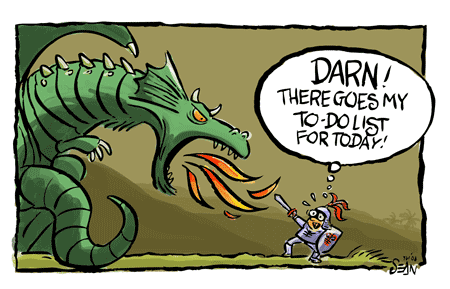A trick I once read about in some personal development and productivity book was to visualise how your next day was going to go. So, I sat down to daydream and visualise my morning. The idea is that when you visualise it, you can make it happen.
I’d get up, drink a cup of coffee and eat a small, simple breakfast while sitting at the table with my day planner, and peacefully transition from sleepy morning time to mindfulness about the day. I’d get my exercise in, fix my hair, scrub my face, and dress up nicely to face the day with a smile. Every tooth perfectly aligned and white, of course.
My day would be productive, moving from one task to another with stress nor delay. There would be no ADHD moments where I get distracted by this or that, no one would interrupt my work, and everything on my to-do list would get done. Projects would go smoothly from start to finish, and I’d be mostly finished with even big things by the end of the day.
Life doesn’t work like that.

Yep. It’s like this. Image from one of the greatest chaos planners around, Sean from Psychotactics.
Reality: I live in chaos. Instead of breakfast, I grab a cup of coffee, trip over a cat, usher my fiancé out the door to work, glance at the clock and curse about the time, quickly slip on my gym gear and head out. Breakfastless.
You live in chaos. The laundry piles up from time to time, the bathroom probably should get cleaned more often than you do it, and eating regular meals and going to the gym? Only if it’s a priority.
Most of us take a day and say, “I’m going to do all these things.” There could be 3 things on the list or 10 things on the list that need to happen, but in the end you end up getting sidetracked, projects take longer than you expected, errands and chores were twice as long as you planned for, a friend shows up in tears on your doorstep, whatever.
Then, you end up stressed and frazzled. That’s not good for getting things done in the long run, and thus you start to panic, perpetuate the cycle of self-inflicted trauma, doubly so when there is work to be done with a client breathing down your neck and a boss looking over your shoulder.
Chaos is going to happen. Accept it.
If chaos steps into your life anyway, why not invite it in with a cup of tea. One of the best pieces of advice I ever received was from my Sensei, “Don’t fight the chaos, welcome it and allow it to shape your courage, patience, and fortitude.”
Instead of fighting with anything that came up to ruin plans and throw us off, learn to accept that chaos is part of this wonderful reality we call life. Only once you accept that you cannot possibly control life can you plan for chaos. Seriously. Today I have planned to write this post, work on the metacognition class, a few chores, and make banana bread. I know how long it takes to make banana bread, but not how long it takes to write this post with two desperate kittens circling around me begging for attention. In the time I opened the WordPress dashboard, my grandmother called to find out what happened over the weekend, maintenance showed up to fix the tub, and my neighbour asked me for a jump so he could get his van out of the parking lot and to a shop. Two hours… down the drain.
Deep breath. Ready to admit you can’t control it all?
The only “hack” needed is a buffer zone.
I’m not actually all that worried about things at the moment because I had planned my morning to be a buffer zone. I had planned to not really get a single thing accomplished during 2 hours during the morning — just like I do every morning. In that buffer zone I give myself first thing in the morning is guaranteed to be when my brain is the slowest, so I can very easily do things like household chores, make the banana bread, go to the gym, and other semi-mindless tasks while my brain wakes up in the morning.
The key to a buffer zone is to choose a time when your brain is either at its fuzziest or when you are the most scattered. For several of my clients this seems to be in the morning (while they drink their first pot of coffee) or when their kids get out of school and the parents are running them from event to event until after dinner. This is a great time to take along a paper to read while waiting for the kids to get in the van, run for groceries while they are at practise, or even take a siesta.
The mindset to buffer zones are to think of it as “extra time” that you didn’t have anything planned, just to be in the moment. Sure, you might know you have to “take the kids to practise”, but once you’ve run that 15 – 20 minute errand, you don’t “have to do” anything else. Thus, you can reprogramme your brain to think, “I’ve got 45 minutes while they practise… I want to read this paper/go grab coffee/call a friend.”
Where can you plan for chaos in your day?
Take our pilot class and get lifetime access for just $20 today.







